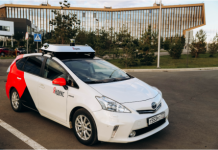AUDI AG, Ericsson, Qualcomm Technologies, Inc., SWARCO Traffic Systems GmbH and the University of Kaiserslautern today announced the successful completion of the world’s first-announced C-V2X trial. Initiated in December 2016, the trial utilized a test bed and field tests based on 3rd Generation Partnership Project (3GPP) C-V2X direct and network-based complementary technologies for connected vehicles and Intelligent Transportation Systems (ITS). The tests were designed to provide further evidence of the complementary nature of short-range direct and cellular wide-range communication with C-V2X and received results demonstrating the reliability and performance of the vehicle-to-everything (V2X) technology. The organizations formed the Connected Vehicle-to-Everything (V2X) of Tomorrow (ConVeX) consortium in December 2016, and since have successfully completed and analyzed end-to-end implementation and performance testing in realistic driving conditions.
During the project, ConVeX, which is co-funded by the German Federal Ministry of Transport and Digital Infrastructure (BMVI), tested and demonstrated several use cases for C-V2X, including Vehicle-to-Vehicle (V2V) and Vehicle-to-Infrastructure (V2I) direct communication operating in the 5.9GHz ITS frequencies, as well as Vehicle-to-Network (V2N) wide area communication. For these tests, Audi vehicles and SWARCO’s intelligent road infrastructure were equipped with C-V2X technology based on the Qualcomm® 9150 C-V2X Platform.
ConVeX investigated the reliability, range and performance of C-V2X direct communication using 5.9 GHz between vehicles and with infrastructure at varying speeds. Testing delivered 100 percent reliable reception of safety messages in line of sight conditions of up to 1.2 km, with the distance limited by the length of the test roads. The test was conducted with relative vehicle speeds between two vehicles traveling in opposite directions of up to 430 km/h. These tests were conducted at two locations on the German A9 and A6 motorways.
Tests were also conducted in urban conditions with completely “blind” intersections and showed at least 140 m range with safety messages delivered at 100 percent reliability for the V2V communication, which underlines the high effectiveness of C-V2X direct communication over multiple use cases, for example Intersection Movement Assist (IMA), Left Turn Assist (LTA), and Forward Collision Warning (FCW).
In parallel to real world tests, extensive simulations were conducted by the Technical University of Kaiserslautern to corroborate the very good field performance of C-V2X.
V2N testing leveraged an Ericsson network supporting 5G concepts such as network slicing and geo-casting for use cases such as hazardous icy road alert. Thanks to the characteristics of 5G cellular networks, traffic information is consistently delivered with low latency and high reliability over arbitrarily long ranges that are determined by the application needs, rather than by communication capabilities.
During the trial, ConVeX also demonstrated the reliability, range and performance of the communication technology with the world’s first cross-border demonstration for C-V2X direct communication between vehicles and with infrastructure across the three Trans-European borders, which included France, Luxembourg and Germany. The detailed project results from this trial, as well as all related documentation can be found at the ConVeX website https://convex-project.de/deliverables.html












